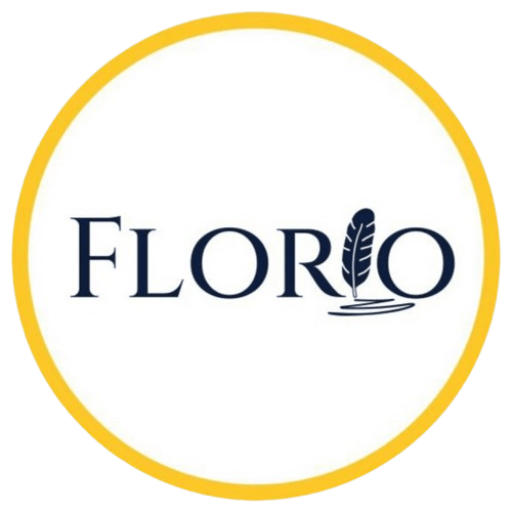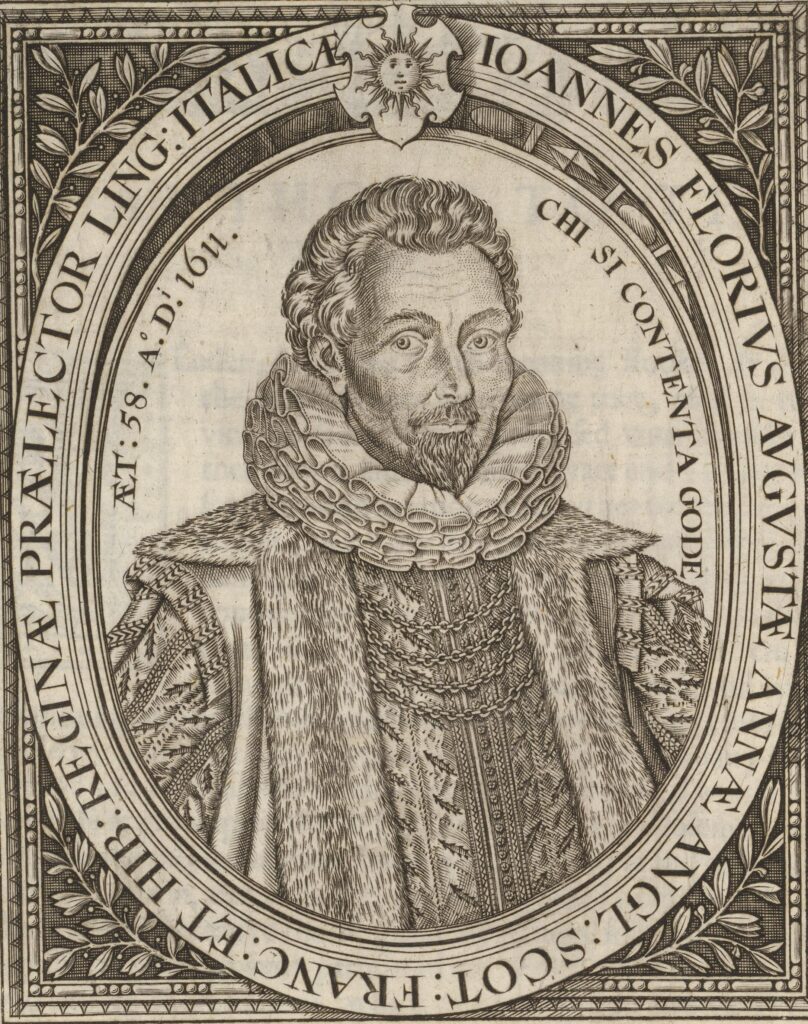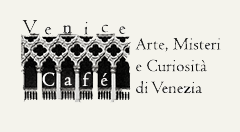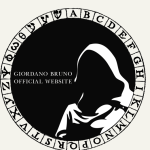While he was engaged in the service of Henry Wriothesley, Florio produced a work which remains a landmark in the history of Italian scholarship in England. A Worlde of Wordes, or Dictionarie of the Italian and English tongues (London, 1598) is an Italian-English Dictionary, and, as such, only the second of its kind in England and much fuller than the short work published by William Thomas in the 1550s – with 44,000 words as opposed to Thomas’s 6,000. 1 Published by Edward Blount, and dedicated to Roger, Earl of Rutland, Henry, Earl of Southampton, and Lucy, Countess of Bedford, this work marked Florio as a scholar of the first magnitude. When Florio compiled it, he graciously acknowledged his predecessor in the field of Italian-English lexicography: “our William Thomas hath done prettilie”, he says. He goes on to inform us in his address “To the Reader” that he got the idea of making this dictionary twenty years previously when he saw in manuscript the beginnings of a collection of material for an Italian dictionary made by a gentleman of “worshipful account” and “well experienced in the Italian.” The name of this gentleman is not known and the work was never published. It is possible that this ‘gentleman’ was his father Michelangelo.
The Epistle Dedicatorie
In his lenghtly “Epistle Dedicatorie” he invites his three talented private students and patrons Roger Earle of Rutland, Henry Earl of Southampton, and Lucie Countesse of Bedford to the christening and protection of the dictionary likened to a “bouncing boie, Bacchus like”, generated by an Italian Semele and an English thigh. Florio compares the difficulty of his work with that of the Tuscan poets, especially Dante, and of the Renaissance authors, such as Castiglione, Aretino, Garzoni, Citolini, and others. He explains that its usefulness extends to the variety of Italian dialects, from Venetian to Roman, Lombard, and Neapolitan: “so manie, and so much differing Dialects, and Idiomes, as be used and spoken in Italie, besides the Florentine,” challenging even native Italians:
“And I have seene the best, yea naturall Italians, not onely stagger, but even sticke fast in the myre, and at last give it over, or give etheir verdict with an ignoramus“.
English: John Florio’s sweet mother tongue
In the Epistle Dedicatorie John Florio celebrates the Italian language; however, his attitude towards English language is now changed. If in First Fruits he found the language “besitted with manu languages” now he’s moved a step nearer appreciating what he now defines the “sweete-mother-toonge” of his native land. At this point of his life John Florio defines himself as Englishman, despite will be forever defined as foreigner. Clearly, he did wish this work to assist his pupils, and others, on their journeys through the works of such figures like Petrarca, Dante, Castiglione, and Guazzo:
“The retainer doth some service, that now and then, but holds your Honors styrrop, or lendes a hande ouer a stile, or opens a gappe for easier passage, or holds a torch in a darke waie.”
A growing confidence in his linguistic abilities is in evidence when he asserts:
“If any man aske whether all Italian wordes be here? I answere him, it may be no: and yet I thinkee here may be as many, as he is likely to finde (that askes the question) within the compasse of his reading; and yet he may haure read well too.”
A seafaring adventure
As Florio is a go-between for different social classes both as an insider and an outsider, as a preceptor and translator, A World of Words is a go-between for Italian and English, different languages and cultures, Venice and Europe, written and spoken language, formal and informal interactions, classical antiquity and early modernity. The originality of this work cannot be overstated. It is filled with life, enthusiasm, humanist thirst for knowledge, fantasy, and the passion of an author eager to establish himself as a master of his craft. Florio likens his lexicographic enterprise to seafaring adventures with the risk of shipwrecks and refers to works on other languages undertaken by Thomas Eliot, John Ride, and the “Stephans” who had an “advantage on me, that they were many to steere a passage-boat”:
“I was but one to turne and and winde the sailes, to use the oare, to sit at asterne, to pricke my carde, to watch upon the upper decke, boate-swaine, pilot, mate, and master, all offices in one, and that in a more unruly, more unweildie, and more roome-some essel, then the biggests hulke on Thames (…) and that in a sea more divers, more dangerous, more stormie, and more comfortlesse then any Ocean.”
¶ A World Of Words – Florio’S Sources
The cited sources that follow the “Epistle Dedicatorie” of 1598 include a corpus that is made up mostly of contemporary literary texts, ranging from Sannazaro‘s Arcadia and Tasso‘s Gerusalemme Liberata to Castiglione‘s Cortegiano, Della Casa’s Galateo, and Caro’s Lettere famigliari, as well as wide range of Dialoghi such as those written by Sperone Speroni and Stefano Guazzo.
Aretino’S Erotic Content
Fourteen citations alone or one-sixth of the catalogue are sources from Pietro Aretino, highlighting Florio’s interest in theatrical texts and his willingness to capitalize on his English readers’ salacious interest in Aretino’s explicitly erotic and sexual content. Florio was shrewd enough to realize that if his Italian-English dictionary drew much of its vocabulary from such a popular author as Aretino, it would be well received by all those who wished to study first-hand Aretino’s lashing satire, bawdy language, and journalistic style. 1
Plays, Poetry & Dialogues
Apart from using the material supplied by the four main bilingual dictionarie of the time (Thomas, Venuti, Las Casas and Fenice) and the encyclopedic works of Citolini and Garzoni, Florio consulted volumes on such topics as horsemanship (Grisone) cookery (Messisbugo), falconry (Federico Giorgi), botany (Gerard, Laguna and Mattioli), zoology (Gesner), and history (Gandini and Nardi). He also extracted words from a large number of plays and collection of poetry, dialogues and letters.2 Florio offered cultivated English Italophiles an instrument for understanding hidden meanings, idioms, words and phrases of dialect, and proverbs in a wide range of 72 literary works, including 22 placed on the Index, a list of prohibited texts published following Italy’s Tridentine Council.
¶ A World Of Words: 46.000 Italian Entries
Florio’s compilation of the first comprehensive Italian-English dictionary, is the culmination of a lifelong endeavour in the dissemination of Italian language and culture in Renaissance England, and a tribute to the wealth of early modern Italian civilization. 3 At a time when Italian-English lexicography was still at its infancy, Florio’s corpus of 46,000 Italian entries, and a much larger number of English words, is nothing short of a trailblazing enterprise. Inspired by Tommaso Garzoni’s Piazza Universale della Lingua, A World of Words is based predominantly on words and phrases found in contemporary Italian literature, monolingual and bilingual dictionaries by Francesco Alunno, Filippo Venuti, and words from disparate fields of knowledge. Florio was attempting to compile a glossary of words relating to as many and as varied subjects as he possibly could.
An Encyclopedic Dimension
John Florio’s dictionary A World of Words contains not only single word entries, but also phrases, idiomatic expressions, and exclamations, side by side with a wealth of scholarly and technical terms, all of which lend a genuinely encyclopedic dimension. It would be an error to consider him primarily either a grammarian or a philologist. Indeed, it is very doubtful whether such description ever properly fitted him, notwithstanding his World of Words and the much augumented Queen’s Anna New World of Words. His love for words and language, in fact, is more rhetorical than grammatical or philological.
A World Of Words: A Plurilingual Dictionary
Unlike the purist-oriented Vocabolario degli Accademici della Crusca, which was published 14 years later (1612), A World of Words is inclusive rather than exclusive, plurilingual rather than monolingual, providing a broad range of expressions related to the material, sensory world, through expressive and picturesque language.
Florio’S Picturesque Language
Words like potta or fica, (“a womans privie parts, a cunt, a quaint”) cazzo, coda, or destriere (“a mans privie member”) and puttanaria (“whoredome, the arte of whoring”) and metaphors such as Donna che manda il marito in Cornovaglia senza barca or Donna che fa le fusa storte (“shee that makes hir husband cuckold” [literally “a woman who sends her husband to Cornwall without a boat”]; “a woman who purs”), appear along with interjections such as cancaro, a Paduan dialect word Florio takes from Ruzzante, an Italian actor and playwright; cappari, jocular phrases and terms such as alla tua barba, culatorio, hyperbolic language such as Io t’ho dove si soffiano le noci (“I care not a turd for you”) and expressions in “Peddlers” French.
Florio: A Modern Approach
Florio chose this precociously modern approach in a politically and culturally ambivalent environment in which Puritanism and libertinism coexisted, and where the celebration of all things Italian was challenged by xenophobic voices such as Roger Ascham’s, for whom “un Inglese Italianato é un diavolo incarnato.” 4
A World Of Words – Florio’s Inventiveness: Copia
Language contact with English and ‘overseas’ languages is another feature of the English definitions that highlights Florio’s global interests and exposure to different cultures. Gallicisms appear as the most frequently recurrent loanwords, owing to the historically strong contact between the French and English language, but also to Florio’s fluency in French and experience in translation. Fanciful definitions criss-cross the dictionary, revealing Florio’s inventiveness as a writer. It is here that we find perhaps his strongest expression of Renaissance copia, with his passion for explications and amplifications. Numerous single nouns, adjectives, and verbs among the Italian entries are explained with ten, twenty, even forty terms and definitions. In his pursuit of copia, Florio offers no fewer than 44 definitions for ragione, while for tiro 67 items, and 45 for vago.
Florio’S Ability As Translator: Some Examples
Florio gives evidence of his ability as a translator as he lists a host of synonyms to explain the Italian word:
Rompere, to breake, to batter, to bruze, to ouerthrow, to vanquish, to destroy, to weaken, to abate, to represse, to maister, to tame, to subdue, to confute, to overcome, to teare, to splint, to shiuer, to rent, to scatter, to totter, to tug, to hauock, to spoile, to defeate, to crush, to craze.
Quantity: A Primary Objective
As noted in the “Epistle Dedicatorie”, Florio was constantly striving to find new words, with an almost unparalleled lexical voracity. To cite Frances Yates, he “loved words with an aesthetic delight in their strength, delicacy, colour, and infinite variety. He collected them into his dictionary as another might collect jewels in a cabinet.” Quantity was a primary objective, and Florio endeavoured to challenge any potential competitor:
“If any thinke I had great helpes of Alunno, or of Venuti, let him confer, and knowe I have in two, yea almost in one of my letters of the alphabet more words, then they have in all their twentie; and the yare but for a few auctors in the in the Italian toong, mine for most that write well, as may appeere by the Catalog of bookes that I have read through of purpose for the accomplishing o this Dictionarie.”
Conrad Gensner’s Historia Animalium, to take one example, not only furnished him with the Tuscan words for the English “bat” – pipistrello and nottola, but also the Neapolitan form sporteglione, probably acquired thanks to his friendship with Giordano Bruno. And the Emilian barbastrello and the Ligurian ratto pennago, all of which are recorded, without qualification, in the dictionary. Similarly, Florio registered a number of words for “butter”: besides the Tuscan burro, one finds the northern Italian forms botero, botiro, butiro and butire, the Southern Italian butturo, the Venetian smalzo, and even penco, a word which is only used in the Val Bregaglia, Switzerland, where Florio spent his childhood. 5
Figurative Meanings
Multiple definitions are frequently accompanied by figurative meanings. Wherever possible, he tries to supply an English equivalent for an Italian concept or expression:
Framponato, a kinde of high horse shooe, such as the bruers horses use in London.
Mazziere, a macebearer, a veger, a sergeant of the mace. Also a halbardier or poleaxe man, such as the Queen of England’s gentlemen pencioners are.
When he encounters in his Italian sources words relating to the animal, vegetable and mineral world, Florio includes in his dictionary the same humorous and fabulous definitions that one finds in Pliny and the medieval Bestiaries7 :
Scolopendra, a fish that casteth out his bowels until the hooke wherewith he is taken be out, and then sucketh up againe.
Laucrocuta, a beast that hath all his teeth of one piece, as big as an asse, with neck, taile and breast like a lyon, and head like a cammell, and counterfeits the voice of a man.
Etiopide, an herbe which caste into the water, it will dry it up, and if horses treade upon it, it will make them caste their shooes.
A World of Words is a work of art in itself, the dictionary is an extraordinary resource not only for the history of Italian in Italy and abroad, but also for the history of early Modern English. It is a work that brings together the author’s three major roles: Florio as the plurilingual reader and word collector; Florio as teacher of Italian language and culture, as a grammarian and paroemiologist; and Florio as translator and creative writer.
Bibliography
- Hermann, W. H. John Florio: A World of Words, University of Toronto Press, 2013.
- O’Connor, D. J. John Florio’s contribution to Italian-English lexicography, Italica, Vol. 49, N. 1 (Spring, 1972), pp. 49-67, p. 49.
Notes
- O’Connor, D. J., John Florio’s contribution to Italian-English lexicography, Italica, 49, 1972, 49-67, p. 49
- O’ Connor, D. ., John Florio’s contribution, cit., p.51
- Hermann, W. H. John Florio: A World of Words, Introduction.
- Fur further details, read the paragraph Florio and his enemies in the page Second Frutes.
- O’ Connor, D.J. John Florio’s contribution to Italian-English lexicography, Italica, Vol. 49, N. 1 (Spring, 1972) pp. 49-67, p. 52.




